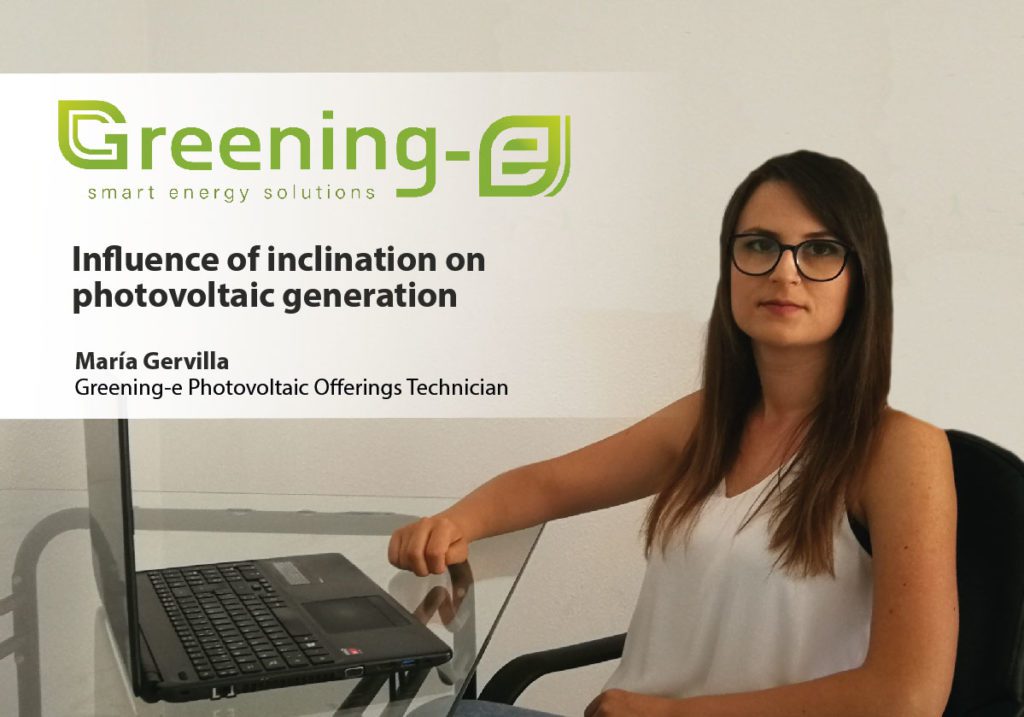For photovoltaic production to be efficient, several factors are necessary, among which the tilt stands out. Our colleague María Gervilla, technician in the Greening-e Offers department, explains.
When we talk about photovoltaic energy, there are many factors that can affect the optimal generation of our modules. This is why, to obtain the best performance in a photovoltaic installation, it is essential to take into account a series of factors, such as the inclination of the panels, which will have a direct influence on the behavior of the system:
- Solar radiation received at the surface of the module. This variable will in turn depend on the location of the installation.
- Orientation of the system.
- Inclination of the system.
- Shadows that can affect the photovoltaic modules.
- Electrical losses.
- Ventilation of the photovoltaic modules.
Specifically, we will focus on the tilt of the photovoltaic system, because as we can see, part of the rest of the variables are directly related to the previous one.
Selecting the optimum incline
The solar radiation that reaches the plates perpendicularly to their surface will always be greater than if the module is placed in a direction other than perpendicular. However, the solar azimuth and height are variable throughout the day and year, so if we use fixed systems, this optimal inclination can only be reached at one time of the day.
Finding the optimum incline is not an easy task. Different factors influence this decision like the movement of the planet, as mentioned earlier, as well as the customer’s own consumption habits. There is a generally applied rule, which states that the angle of inclination should be equal to the latitude of the place.
However, when we take into account the customer’s consumption habits, if it increases considerably in winter, it will be necessary to increase the inclination between 10 and 15 degrees compared to the previous one. Indeed, the sun is lower and its incidence is more horizontal.
On the other hand, if our consumption increases in summer, we will have to reduce the inclination to between 10 and 15 degrees in order to obtain the opposite result when the sun is in a higher position.
Selecting the optimum inclineImprove radiation and ventilation through the use of inclined structures
There are also various factors directly related to the tilt of photovoltaic modules.
Ventilation of the system is essential to reduce electrical losses. Despite the widely held opinion that at a higher temperature the performance of the solar panel increases, this is a false myth, since the maximum performance point of a solar panel is when the environment is more temperate.
As with other devices that conduct or produce electricity, heat negatively affects the plates, reducing their performance.
For this reason, adequate ventilation is essential, so that excessively high temperatures are not reached and the performance of the system is reduced. For instance, most manufacturers report that production decreases at 40 °, reaching yields of 80%.
The increase in the inclination of the photovoltaic generator allows natural and continuous ventilation to be produced under the modules, reducing the increase in temperature. These air currents that form around the panels help them stay as close to room temperature as possible, thus improving the system’s performance during the warmer months.
Space and shadow issues
Despite all the above, the use of triangular structures, more or less inclined, has a series of disadvantages that must be taken into account before planning our installation.
The distance between the rows of photovoltaic modules and the inclination are directly related. By increasing the inclination, the distance to be considered between these rows must be greater to avoid shading problems. When the sun’s rays fall on the surface of the panels, they generate significant shading that must be avoided. Indeed, full or partial shadows can stop the generation of a complete chain.
This problem results in a need for a much larger available surface in the case of triangular installations, which have a strong inclination. In the case of coplanar installations, where the proper inclination of the roof is taken advantage of, it is not necessary to maintain considerable distances between the modules, beyond those necessary for carrying out maintenance tasks.
The continuous evolution and expansion of photovoltaic installations has increased the supply of solar panels. This translates into a considerable reduction in their price and the ability to install higher peak power at lower prices than their triangular analogue. In addition, the use of coplanar structures reduces the problem of partial shading, which is why they become a stronger bet in the projection of installations.

